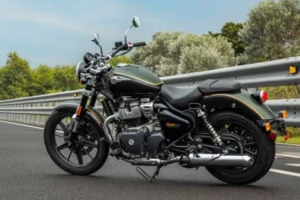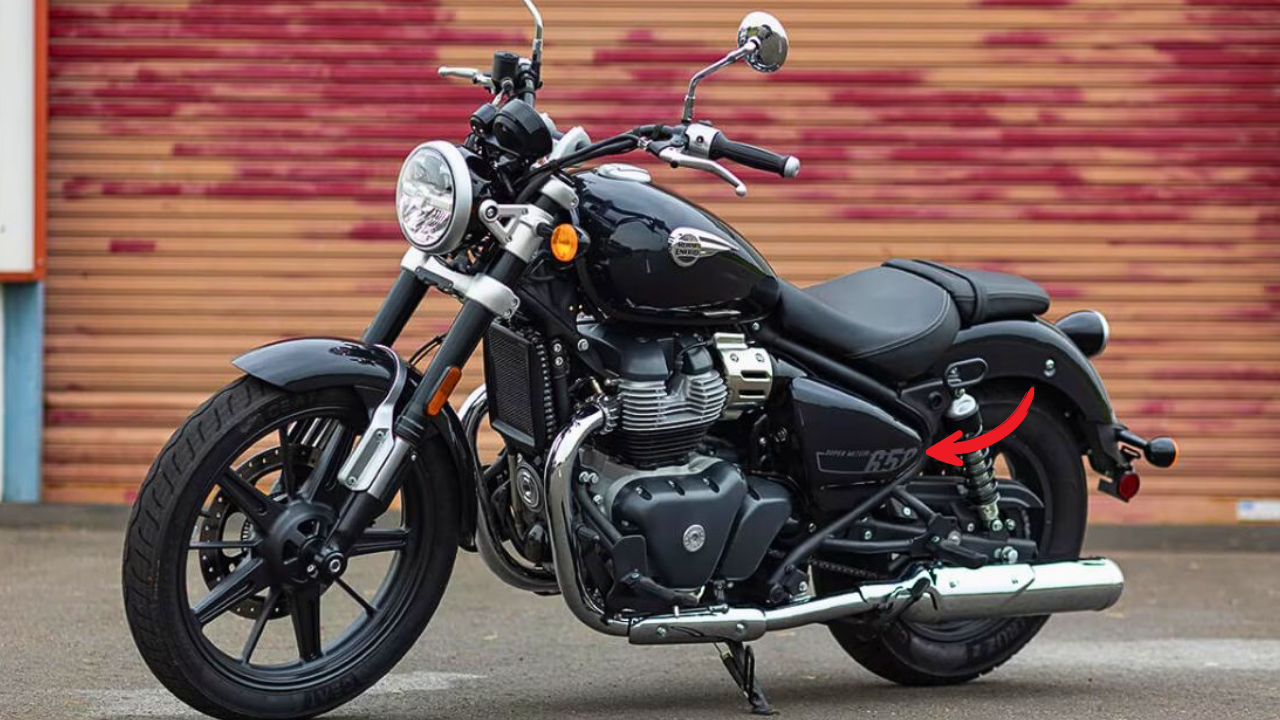Royal Enfield, the iconic Indian motorcycle manufacturer, has long been synonymous with retro charm, robust build quality, and a riding experience that resonates with enthusiasts worldwide. The Super Meteor 650, launched in 2023 as the brand’s flagship cruiser, has been a standout in its 650cc lineup, blending classic cruiser styling with modern features. Recent spy shots of an updated Super Meteor 650 testing in Spain have sparked excitement among fans, hinting at a refreshed model potentially slated for a 2026 launch. With subtle but significant changes to the suspension, rider seat, and possibly the instrument cluster, this updated version promises to elevate the cruising experience further. This article delves into the details of the spied test mule, the potential upgrades, and what this means for Royal Enfield’s future in the middleweight cruiser segment.
Background: The Super Meteor 650’s Legacy
The Royal Enfield Super Meteor 650 made its global debut at the 2022 EICMA show in Milan, Italy, and quickly became a favorite among cruiser enthusiasts. Built on the same 648cc parallel-twin platform as the Interceptor 650 and Continental GT 650, the Super Meteor 650 was designed for long-distance cruising with a low-slung seat, relaxed ergonomics, and a muscular retro design. Available in three variants—Astral, Interstellar, and Celestial—it offers seven color options, including Astral Black, Interstellar Grey, and Celestial Red, and is priced between ₹3.68 lakh and ₹3.99 lakh (ex-showroom) in India.
The Super Meteor 650 is powered by a 648cc, air/oil-cooled, parallel-twin engine producing 47 PS at 7,250 rpm and 52.3 Nm of torque at 5,650 rpm, mated to a six-speed gearbox with a slipper clutch. Its hardware includes upside-down (USD) front forks—a first for Royal Enfield’s 650cc range—twin rear shocks, and single-disc brakes with dual-channel ABS. The cruiser rides on tubeless alloy wheels (19-inch front, 16-inch rear) wrapped in CEAT Zoom Cruz tires, ensuring stability and traction. Additional features like an LED headlight, a semi-digital instrument cluster with Tripper navigation, and premium fit-and-finish have made it a compelling option against rivals like the Kawasaki Vulcan S and Benelli 502C.
Despite its success, some riders have noted areas for improvement, such as the stiff ride quality over bad roads, limited ground clearance (135 mm), and the heavy kerb weight of 241 kg. Some posts have specifically called for a 15 mm increase in ground clearance to enhance practicality. These criticisms appear to have been taken seriously, as the latest spy shots suggest Royal Enfield is addressing these pain points.

The Spied Test Mule: What’s New?
In June 2025, a test mule of the Royal Enfield Super Meteor 650 was spotted undergoing trials on the streets of Spain, as reported by multiple sources including NDTV, BikeWale, and RushLane. The bike, clearly marked with a “650” decal on the side panel, dispels rumors of it being a 750cc variant, confirming it as an updated version of the existing model. While the overall design remains largely unchanged, several upgrades stand out, signaling Royal Enfield’s intent to refine the Super Meteor 650’s performance and comfort.
1. Retuned Suspension Setup
One of the most significant changes observed on the test mule is the revised suspension system. The current Super Meteor 650’s USD front forks and twin rear shocks, supplied by Showa, have been criticized for delivering a firm ride, particularly on uneven surfaces. The spied bike features what appears to be a retuned USD fork, with a testing device attached to the front suspension, likely used to measure performance metrics like damping and travel. The rear shocks also seem to be updated, potentially offering improved preload adjustability or a softer tune for better comfort.
Posts on X, such as one from @PowerDrift, confirm these observations, noting “revised rear shock absorbers” and a “likely retuned USD fork.” These changes align with user feedback about the need for a more compliant ride, especially for long-distance cruising on varied road conditions. By fine-tuning the suspension, Royal Enfield aims to enhance the bike’s appeal as a highway-friendly cruiser while addressing complaints about its stiffness.
2. Thicker Rider Seat
Comfort is a hallmark of any cruiser, and the Super Meteor 650’s low, wide seat (765 mm height) has been praised for its relaxed ergonomics. However, the test mule sports a visibly thicker rider seat, suggesting an upgrade in padding or foam density to improve comfort during extended rides. This change, noted by @PowerDrift and @autocarindiamag, could reduce fatigue on long journeys, making the bike more appealing to touring enthusiasts.
The thicker seat may also contribute to a slight increase in seat height, which could indirectly address concerns about ground clearance. While no official measurements are available, even a modest increase could help the bike navigate speed bumps and rough roads more effectively, responding to user demands like those voiced by @Prof_Shambhu.
3. Potential TFT Display Upgrade
A standout feature on the test mule is a digital display mounted above the LED headlamp, resembling the TFT instrument cluster found on the Royal Enfield Himalayan 450. The current Super Meteor 650 uses a retro-inspired semi-digital console with an analog speedometer and a small LCD for fuel, trip, and navigation data via the Tripper system. The spied TFT display, if included in the production model, would be a significant upgrade, offering modern features like Google Maps integration, music control, and a more intuitive interface.
RushLane speculates that this “Tripper Dash” could transform the user experience, making the Super Meteor 650 a more tech-savvy cruiser. This aligns with Royal Enfield’s recent push to incorporate advanced electronics, as seen in the Himalayan 450 and Guerrilla 450. However, it remains unclear whether the TFT display will be standard or an optional accessory, as the current Tripper navigation is offered as an add-on in some markets.
4. Mechanical Continuity
Despite the updates, the test mule retains the same 648cc parallel-twin engine, ruling out speculation about a new powertrain. The engine, paired with a six-speed gearbox, is expected to maintain its output of 47 PS and 52.3 Nm, with no significant retuning reported. The absence of a dual-disc brake setup at the front further confirms that this is not a 750cc model, as Royal Enfield’s upcoming 750cc lineup (Interceptor 750, Continental GT 750, and Himalayan 750) features dual front discs.
The continuity of the engine suggests Royal Enfield is focusing on refinement rather than reinvention, leveraging the proven reliability and performance of the 648cc platform. The bike’s retro styling, including the teardrop fuel tank, round headlamp, and chrome accents, also remains intact, preserving its classic cruiser aesthetic.
Context: Royal Enfield’s Broader Strategy
The spied Super Meteor 650 is part of Royal Enfield’s aggressive product development strategy, which includes multiple new models across its 350cc, 450cc, 650cc, and upcoming 750cc platforms. The brand dominates the 500cc+ segment in India with over 90% market share, driven by the success of its 650cc twins (Interceptor, Continental GT, and Super Meteor). The company is also expanding its electric sub-brand, Flying Flea, and testing models like the Classic 650, Shotgun 650, and Himalayan 450.
The updates to the Super Meteor 650 reflect Royal Enfield’s commitment to addressing customer feedback while staying competitive in the global cruiser market. By enhancing suspension, comfort, and technology, the brand aims to solidify the Super Meteor’s position against rivals like the Kawasaki Vulcan S (priced at ₹7.35 lakh in India) and Honda Rebel 500 (available in international markets). The potential 2026 launch timeline, speculated by RushLane, aligns with Royal Enfield’s pattern of rolling out mid-cycle refreshes to keep its lineup fresh.
User Sentiment and Expectations
Posts on X highlight strong community interest in the updated Super Meteor 650. @bikedekho’s post about “two major changes” dealing with bad roads suggests the suspension and seat upgrades are well-received, while @AckoDrive’s mention of “visible changes” has fueled anticipation. However, users like @Prof_Shambhu emphasize practical improvements, such as increased ground clearance, indicating that Royal Enfield must balance aesthetic and functional enhancements to meet diverse rider needs.
The Super Meteor 650’s appeal lies in its blend of affordability, style, and performance, making it a popular choice for both new and seasoned riders. The spied updates address common pain points, potentially broadening its appeal to riders seeking a versatile cruiser for urban commutes and highway tours alike.
Potential Launch and Pricing
While no official launch date has been confirmed, sources like RushLane and Autocar India speculate a 2026 debut, possibly at a major event like EICMA or Rider Mania in India. The updated Super Meteor 650 is expected to command a slight premium over the current model, with prices likely ranging from ₹3.75 lakh to ₹4.10 lakh (ex-showroom). The inclusion of a TFT display as standard could push the top-end Celestial variant closer to ₹4.20 lakh, but Royal Enfield’s competitive pricing strategy will keep it accessible compared to rivals.
In Summary
The spied Royal Enfield Super Meteor 650 test mule signals an exciting evolution for one of the brand’s most beloved cruisers. With a retuned suspension, thicker rider seat, and the potential addition of a TFT display, the updated model promises to address key rider concerns while enhancing comfort and technology. While the 648cc engine and retro styling remain unchanged, these refinements demonstrate Royal Enfield’s commitment to continuous improvement. As the brand gears up for a possible 2026 launch, the Super Meteor 650 is poised to strengthen its position in the middleweight cruiser segment, offering a compelling blend of classic charm and modern functionality. Riders eagerly await official confirmation, but the spy shots have already set the stage for a cruiser that could redefine long-distance riding for Royal Enfield enthusiasts.

